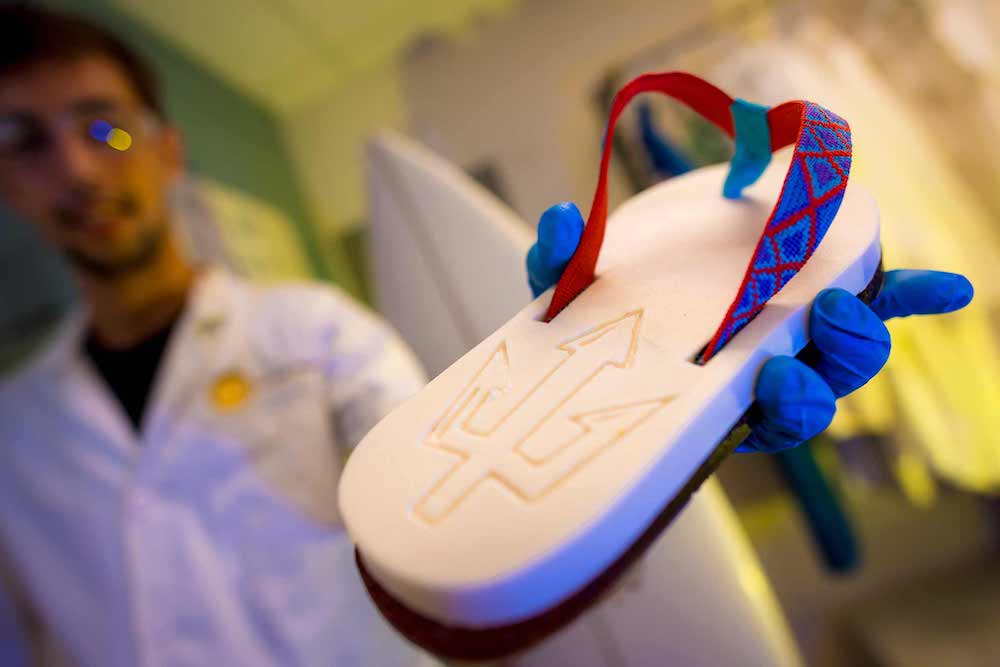Daily Business Report-Oct. 9, 2017
Photos by Erik Jepsen/UC San Diego Publications.
A Flip Flop Revolution
From algae surfboards to sustainable shoes,
a campus innovation
that could change the world
By Kim McDonald | UC San Diego News Center
UC San Diego students and researchers have produced the world’s first algae-based, renewable flip flops.
The first prototypes of their new invention, developed over the summer in a York Hall chemistry laboratory, consist of a flexible, spongy slipper adorned with a Triton logo and a simple strap — fairly basic, as flip flops go.
But when they go into full production later this academic year at what researchers hope will be a projected cost of $3 a pair, the impact of this campus innovation could be revolutionary, changing the world for the better environmentally.
That’s because 3 billion petroleum-based flip flops are produced worldwide each year, eventually ending up as non-biodegradable trash in landfills, rivers and oceans around the globe.
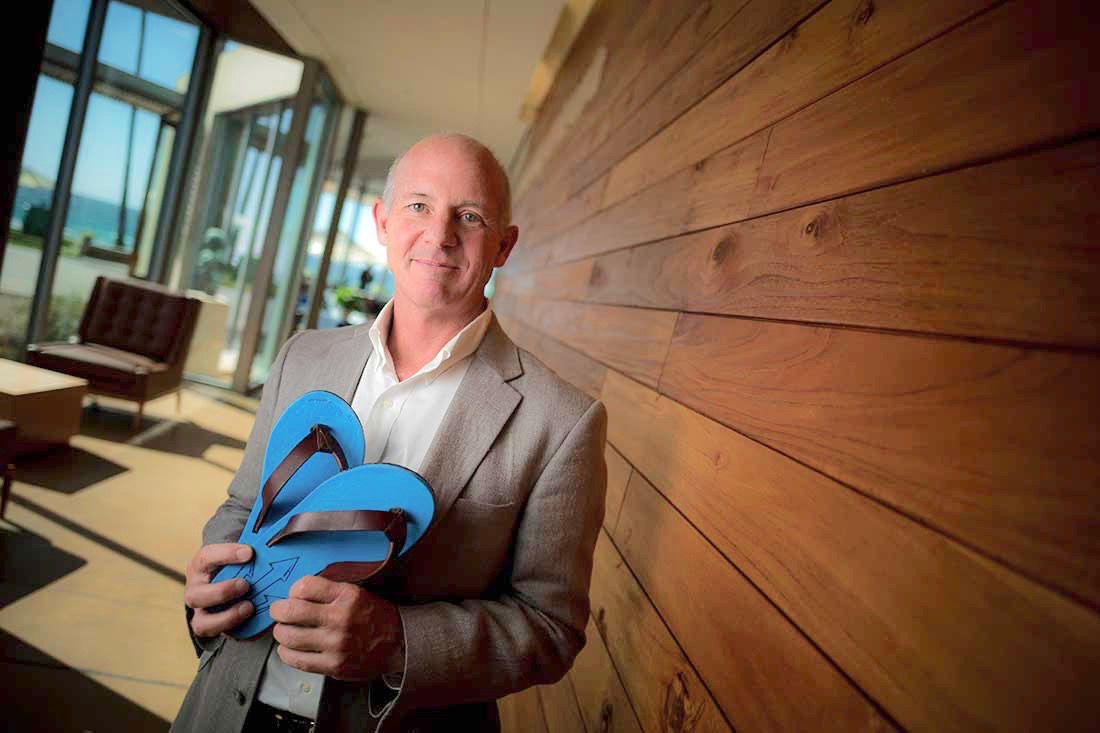
“Even though a flip flop seems like a minor product, a throwaway that everyone wears, it turns out that this is the No. 1 shoe in the world,” says Stephen Mayfield, a UC San Diego professor of biology who headed the research effort with Skip Pomeroy, a professor of chemistry and biochemistry. “These are the shoes of a fisherman and a farmer. This is the No. 1 shoe in India, the No. 1 shoe in China and the No. 1 shoe in Africa. And, in fact, one of the largest pollutants in the ocean is polyurethane from flip flops and other shoes that have been washed or thrown into rivers and flow into the ocean.”
Mayfield and Pomeroy, along with their undergraduate and graduate students, teamed up two years ago to develop the world’s first algae-based surfboard. The UC San Diego scientists worked with a local surfboard blank manufacturer, Arctic Foam of Oceanside, to figure out how to make from algae oil the hard, polyurethane foam core of a surfboard, which is typically constructed from petroleum.
That development, which was quickly embraced by a surfing industry looking for ways to produce more sustainable and environmentally friendly products, got the two UC San Diego professors thinking about their next step.
If this could be done for some of the 500,000 surfboards annually sold around the world, why not for the 3 billion flip flops and millions of other new shoes that each year clutter our landfills and oceans?
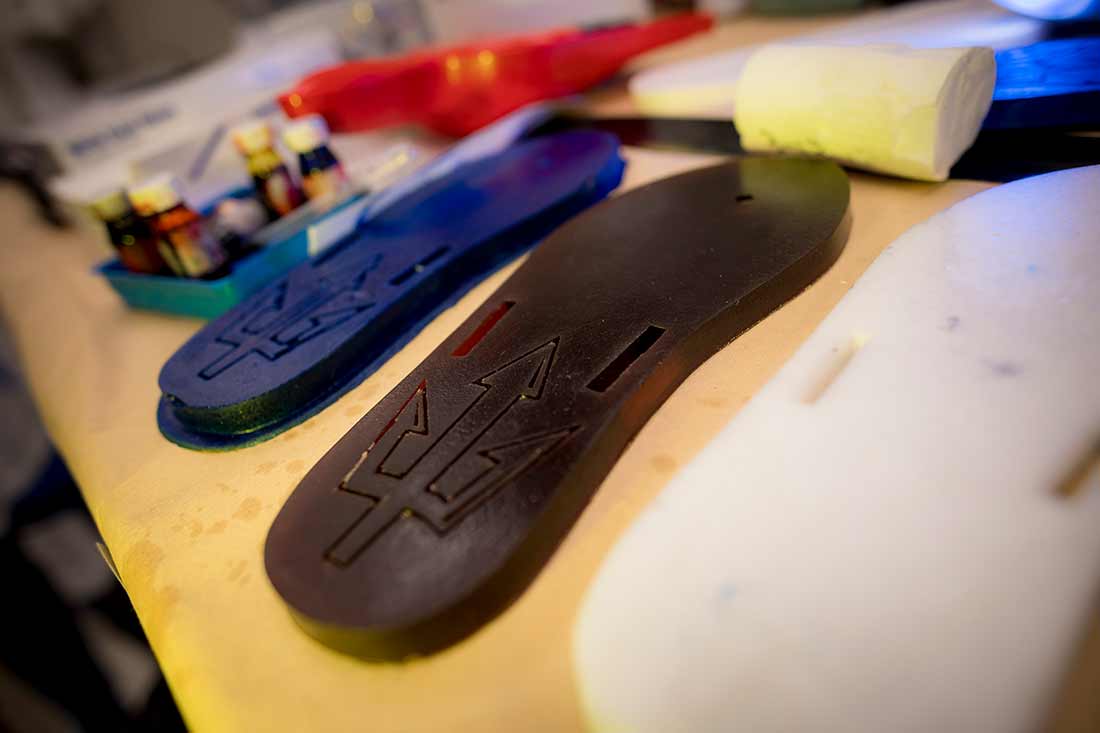
“The algae surfboard was the first obvious product to make, but when you really look at the numbers you realize that making a flip flop or shoe sole like this is much more important,” says Mayfield. “Depending on how you do the chemistry, you can make hard foams or soft foams from algae oil. You can make algae-based, renewable surfboards, flip flops, polyurethane athletic shoes, car seats or even tires for your car.”
To demonstrate the feasibility of their campus-based innovation, Triton Soles, Mayfield and Pomeroy applied for and were awarded last April a $50,000 proof-of-concept grant from the campus Office of Research Affairs. Theirs was one of eight grant awards made in the first year of the Accelerating Innovations to Market program, initiated by UC San Diego’s Office of Innovation and Commercialization, a part of the Office of Research Affairs, and paid for with the help of local elected officials through State Assembly Bill 2664. The goal of the bill is to bring more laboratory inventions from the campus to commercial development.
“Part of the challenge is that typically I’d make a discovery, publish a paper and that’s sort of the end of it,” Mayfield explains. “But the best invention that you keep inside the lab really isn’t valuable for the world. And the way you make that invention valuable is to turn it into a product.”
The two professors, along with Michael Burkart, a professor of chemistry and biochemistry, formed a startup company, Algenesis Materials, which employs some of the students working on the flip flops and other projects and provides them with the opportunity to experience what Pomeroy calls “project-based learning.”
“Teaching chemistry in the classroom is sometimes like trying to teach soccer at the chalkboard,” Pomeroy explains. “In the laboratory, students are far more engaged when they’re actually trying to solve a problem. Most people will tell you that our students are really, really bright, but they don’t always have practical experience. This is a way to provide them with that.”
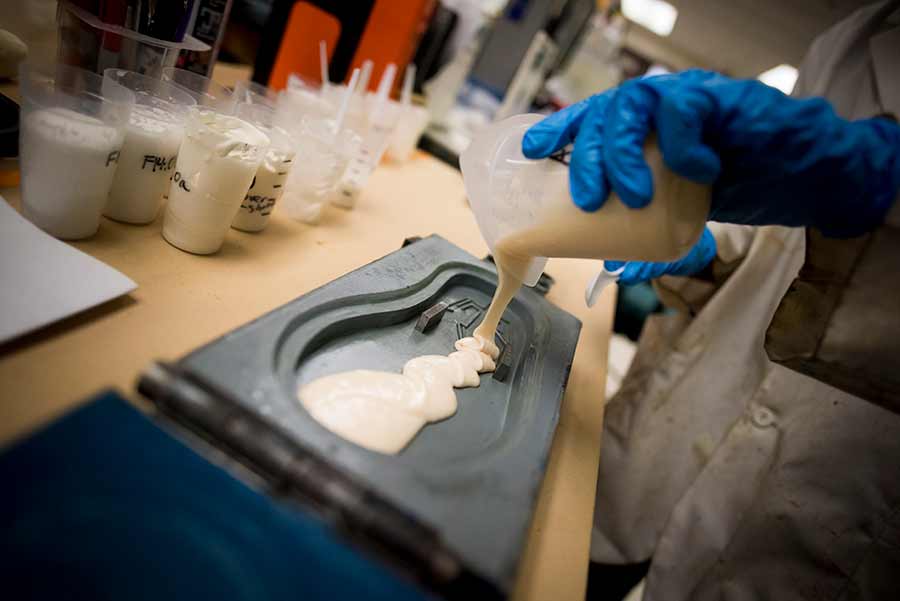
As the first product for Algenesis, the Triton flip flop will allow the three faculty members and students to fine tune the chemistry and manufacturing process for their future shoe soles, car seats and other products traditionally made from petroleum.
“Petroleum comes from algae that lived in the ancient oceans hundreds of millions of years ago,” says Mayfield. “A lot of people don’t know that. But what that means is that anything we can make from petroleum we can ultimately make from algae.”
The Triton flip flops, shoe soles and other polyurethane products the scientists make from living algae oil are “sustainable” because the carbon to construct them was pulled from the atmosphere, rather than underground oil reserves. And the scientists are seeking to also make them “biodegradable,” by chemically converting the algae oil into polyurethane in manner that will allow the carbon bonds to be degraded by microorganisms.
“The idea we’re pursuing is to make these flip flops in a way that they can be thrown into a compost pile and they will be eaten by microorganisms,” says Mayfield.
As a longtime surfer immersed in the ocean environment, Mayfield says that using the expertise he developed over decades studying algae and applying it to develop sustainable and environmentally friendly surfboards, flip flops and other beach products was important to him.
“If we can make these products sustainable and biodegradable, we can impact not only San Diego, but every beach community on the entire planet,” he says. “In San Diego, we have this fantastic surfing culture, many of our faculty and students are surfers, and I think all of us understand because of that connection to the ocean how important the environment is.”
The algae surfboard developed two years ago by students and faculty is now being used by a number of professional surfers and has spawned a new industry. And with the help of a shoe factory in Leon, Mexico, the current plan is to do the same. The first step, however, will be the production of a few thousand pairs of Triton flip flops as a test, which will be provided to UC San Diego alumni and given out for special events.
“It’s going to be a little while before you can buy one of these flip flops in the store, but not too long,” says Mayfield. “Our plan is that in the next year, you’ll be able to go into the store and buy an Algenesis flip flop that is sustainable, biodegradable and that was invented by students at UC San Diego.”
Read this on the UC San Diego News Center site.
______________________
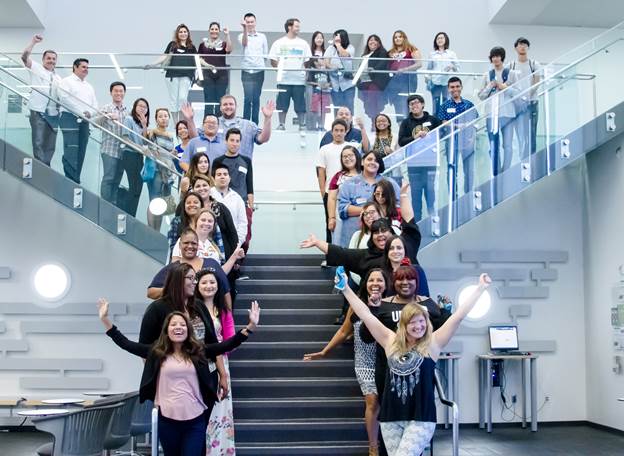
Paid Computer and IT Internships
Offered to Low-Income Students
San Diego Continuing Education (SDCE) and San Diego Workforce Partnership (SDWP) will offer 500 paid computer and information technology internships over the next four years to low-income students through Tech/Hire.
“Students have the opportunity to get career placement help and paid internships, which is not often coordinated within educational organizations,” said Carlos O. Turner Cortez, SDCE president.
While a degree in computer science or mass media can take minimally two to four years to complete, SDCE’s free career education programs in Computer and Information Technology can generally be completed in as little as 360 hours or 18 weeks.
“This is one of the fastest paths for individuals with barriers to change the trajectory of their lives and the lives of their family,” said Turner Cortez. “We have students who need money in their pocket to get through to their next day. We need to help these adults engage in long term goals and help them get out of the cycle of poverty.”
SDCE opened its doors in 1914 to serve the higher education needs of immigrants and refugees. Latino and African-American students currently make up 40 percent of its population of 44,000 students enrolled annually.
______________________
USD Awarded $1 Million Grant
to Reimagine Mathematics
A $1 million grant from The Fletcher Jones Foundation will transform the Mathematics Department at the University of San Diego from its current space into a state-of-the-art environment for student collaboration, faculty research, and community gathering.
The centerpiece of the redesign is the new Math Studio, serving as an incubator and promoter of a radical, physical experience in mathematics research, borrowing ideas from manufacturing, art studios and design thinking. Glass walls, open spaces, and easy navigation are part of the design, allowing fresh new pedagogical approaches and environments that can better reflect and advance mathematics for the 21st century.
“We are thrilled and grateful that The Fletcher Jones Foundation shares our vision to reimagine and engage students in mathematics,” said USD President James T. Harris. “The plan also aligns well with our Envisioning 2024strategic goals of serving as an anchor institution, accelerating our outreach to K-12 teachers and students in the San Diego and Baja region, and promoting advanced research and scholarship across many disciplines.”
With the latest gift, The Fletcher Jones Foundation has given USD more than $5 million in recent years, including funds for the mathematics chair and the Donald P. Shiley Center for Science and Technology.
Construction on the re-design of the Mathematics Department in Serra Hall will begin once spring semester classes end in late May and is scheduled to be completed in time for the fall semester in September.
______________________
SDSU Retains Petco Park Architects
for SDCCU Stadium Plan
Times of San Diego
The Kansas City-based architectural firm that designed Petco Park will begin initial planning of a multipurpose stadium in Mission Valley, San Diego State University athletic officials confirmed. A conceptual design and cost study could be presented by Populous by the beginning of December. The firm also created a rendering for an NFL stadium for the Chargers before the NFL team left for Los Angeles.
______________________
Green Building Rapidly Becoming
Established Part of Home Construction
Proud Green Building
Green construction is rapidly gaining traction among both single family and multifamily home builders, according to the latest in a series of studies conducted by Dodge Data & Analytics in partnership with the National Association of Home Builders. At least one third of single family and multifamily builders surveyed said green building is a significant portion of their overall activity (more than 60 percent of their portfolio). By 2022, this number should increase to nearly one half in both the single family and multifamily sectors, researchers found. Within this group, nearly 30 percent of multifamily builders fall into the category of “dedicated” green builders (more than 90 percent of their portfolio). On the single family side, the percentage of “dedicated” green builders is nearly 20 percent, but that share is expected to grow sizably by 2022.
______________________
Salk Assistant Professor Named
‘New Innovator’ for 2017
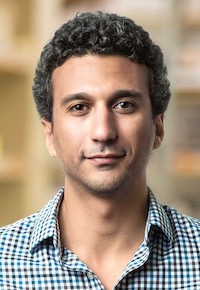
Salk Institute Assistant Professor Eiman Azim has been named an NIH Director’s New Innovator for 2017 as part of the National Institutes of Health’s High-Risk, High-Reward Research Program. The award provides $1.5 million for a five-year project during which Azim will explore how the nervous system controls dexterous movements.
The NIH Director’s New Innovator award is designed specifically to support a small group of creative scientists at an early stage of their career with an emphasis on innovative, high-impact projects, according to the NIH website.
“Eiman employs the most cutting-edge laboratory and imaging technologies to probe how neural circuits achieve motor control,” says Salk President Elizabeth Blackburn. “We are thrilled that his research, which has tremendous potential for life-changing insights into movement disorders, has been recognized with a prestigious NIH Director’s New Innovator Award.”

